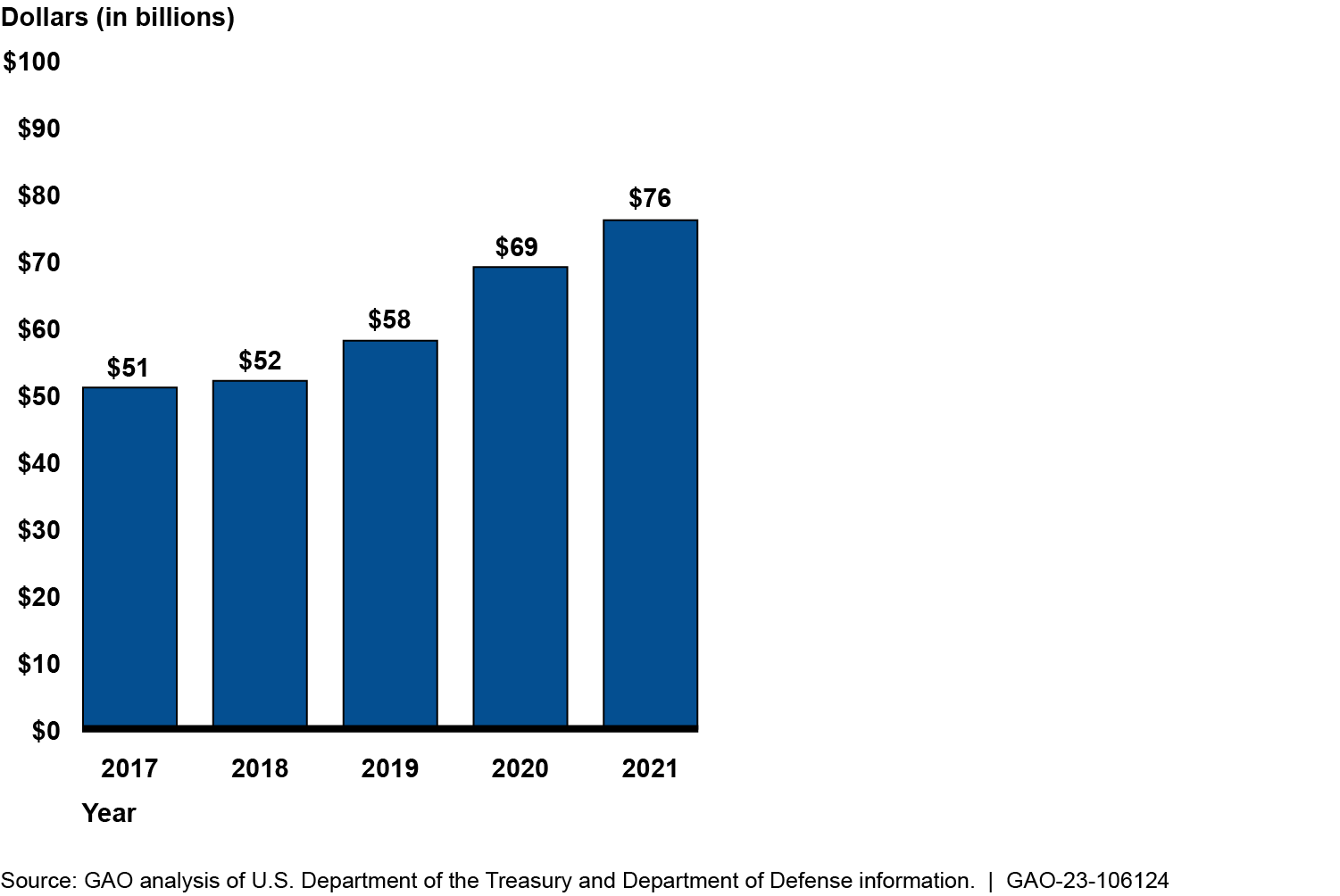Federal Real Property: Agencies Attribute Substantial Increases in Reported Deferred Maintenance to Multiple Factors
Fast Facts
Federal buildings and structures need billions of dollars in maintenance and repairs each year. Agencies can postpone or "defer" this work for a variety of reasons. Over time, this can create a backlog of maintenance and repair needs and result in higher future maintenance costs.
Civilian agencies—i.e., non-military agencies—deferred $51 billion worth of repairs and maintenance in FY 2017. That amount grew to $76 billion in FY 2021. Officials we spoke with at 4 agencies attributed the increase to funding constraints and increases in maintenance and repair costs, among other factors. Our future work will examine this issue in greater detail.
This federal building in Akron, Ohio, awaits major water damage repairs as of January 2022.

Highlights
What GAO Found
Federal agencies maintain and repair a massive real property portfolio of buildings and structures but historically have deferred some of these activities and related costs.
Reported deferred maintenance and repair costs among civilian agencies increased from $51 billion to $76 billion (about 50 percent) from fiscal years 2017 through 2021, according to data from agency financial reports.
Federal Civilian Agencies’ Reported Estimates of Deferred Maintenance and Repairs, Fiscal Years 2017–2021

Note: The U.S. Department of the Treasury aggregates federal agencies’ reported deferred maintenance and repair amounts from their annual financial reports in the annual Financial Report of the United States Government. To identify the civilian agency portion, we subtracted Department of Defense data for the same period as reported in its annual financial reports. The amounts are in nominal dollars; they have not been adjusted for inflation.
Officials GAO interviewed from four selected agencies—Department of Energy (Energy); Department of Health and Human Services (HHS); Department of the Interior (Interior); and General Services Administration (GSA)—attributed increases in their deferred maintenance and repair costs over the period to multiple factors:
- Funding constraints. Officials from all four selected agencies said that maintenance funding had not kept up with costs and had led to increases in deferred maintenance and repairs. For example, GSA officials said that insufficient funding for their maintenance and repair requirements over the past decade had resulted in increasing deferred maintenance and repair needs as well as deterioration in the condition of GSA's portfolio of owned assets.
- Maintenance and repair cost increases. Officials from three of the four selected agencies said that deferred maintenance and repair costs increased due to growing costs associated with aging and deteriorating assets as well as increasing labor and materials costs in general. For example, HHS officials noted that supply chain issues related to the COVID-19 pandemic may have contributed to increased deferred maintenance and repair estimates from fiscal years 2020 through 2021.
- Deliberate deferral. Officials from two of the four selected agencies said that they also deliberately defer some maintenance and repairs for reasons such as a lack of a current need for an asset with scheduled maintenance or agency plans to replace the asset in the near future. For example, officials from a bureau within Interior said that they had elected to defer some maintenance on spillway gates at Hoover Dam because the water level in the reservoir behind the dam had decreased enough that the agency was unlikely to have to use the gates to release water from the reservoir in the near future.
- Data collection changes. Officials from three of the four selected agencies said that new or changed methods for data collection led to increases in reported deferred maintenance and repair costs. For example, Energy officials said that the main cause of an increase of about 35 percent in estimated deferred maintenance and repair costs from fiscal year 2018 through fiscal year 2019 was an initiative undertaken by one of its administrations to improve data quality. The administration used a new software application and updated information to calculate deferred maintenance and repair costs for its buildings, a step that officials said led to about a $2 billion increase over previous calculations.
Why GAO Did This Study
Concerns about agencies' management of deferred maintenance and repair contributed to GAO's placement of federal real property management on its High Risk List in 2003. In its 2011 High Risk Update, GAO found that federal agencies had improved their ability to manage their maintenance and repair backlogs and removed the management of facility condition as a high-risk component. Federal agencies have continued to report billions of dollars in estimated deferred maintenance and repair on their real property assets, representing substantial costs that the federal government may have to pay in the future. Deferred maintenance and repairs can have adverse consequences, including limiting the ability of agencies to carry out their missions and prematurely worsening the condition of assets.
You asked us to review agencies' management of their deferred maintenance and repairs. This report examines reported deferred maintenance and repair costs among civilian agencies from 2017 through 2021 and describes factors selected agencies identified as contributing to changes in their reported costs over this time period.
GAO analyzed civilian agencies' financial reports to identify the estimated deferred maintenance and repair costs the agencies had reported in each fiscal year from 2017 through 2021. GAO interviewed knowledgeable officials at four selected agencies—Energy, HHS, Interior, and GSA—about their agencies' reporting and management of deferred maintenance and repairs. GAO selected agencies using financial report data and federal real property data for factors including a range of asset types and amount of deferred maintenance and repairs, among others. In addition, GAO reviewed its and inspector generals' reports about federal agencies' management of deferred maintenance and repairs.
For more information, contact Jill Naamane at (202) 512-2834 or naamanej@gao.gov.
